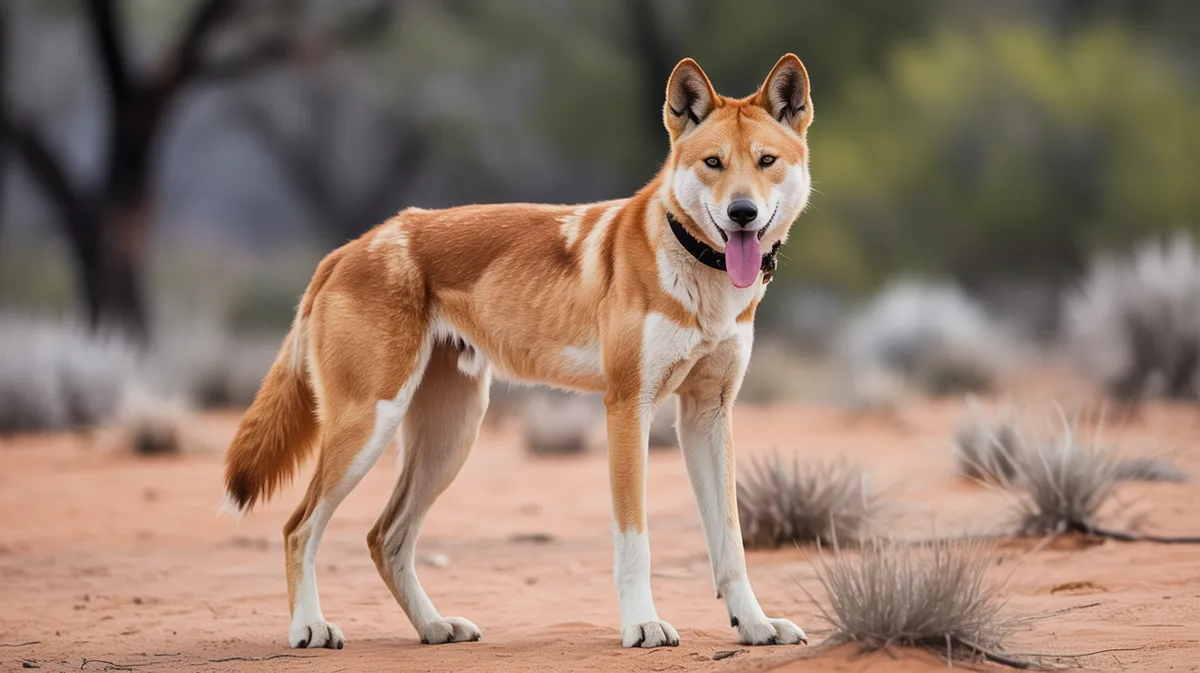
Dingo
Canis lupus dingo
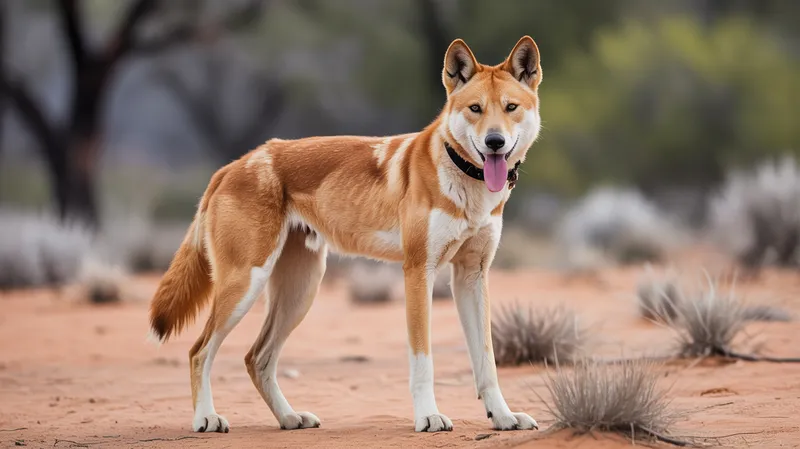
Meet the Dingo
The dingo is a wild dog native to Australia, recognized by its lean body, pointed ears, and bushy tail. Dingoes are highly adaptable predators found across a variety of Australian habitats, from deserts to forests. They play an important ecological role as apex predators, helping to control populations of prey animals. Dingoes are known for their intelligence, social structure, and complex vocalizations. While they can interbreed with domestic dogs, pure dingoes are increasingly rare due to hybridization.
Classification
Mammal
Habitat
Australian deserts, grasslands, forests, and scrublands
Diet
Carnivore
Lifespan
5-10 years in the wild
Conservation
Vulnerable
Weight
13–24 kg (29–53 lbs)
📖Fascinating Facts
Ancient Arrival
Dingoes are believed to have arrived in Australia around 3,500–4,000 years ago, likely brought by seafaring people from Southeast Asia.
Versatile Habitat
Dingoes thrive in many environments across Australia, including arid deserts, tropical forests, grasslands, and mountainous regions.
Unique Communication
Unlike domestic dogs, dingoes rarely bark; instead, they communicate through a series of howls, yelps, and other vocalizations.
📋Detailed Description
The dingo (Canis lupus dingo or Canis familiaris dingo) is a medium-sized canid, typically weighing between 13 and 20 kg (29–44 lbs) and measuring 48–59 cm (19–23 in) at the shoulder. Dingoes have a lean, athletic build, with a broad head, erect pointed ears, and a bushy tail. Their coat is usually short and varies in color from sandy yellow to red-ginger, though black, tan, and white markings can occur, especially in populations with some domestic dog ancestry. Adapted for endurance, dingoes possess long limbs and flexible joints, allowing them to travel vast distances—often up to 10–20 km per day—in search of food and water. Their dentition is robust, with pronounced carnassial teeth suited for shearing flesh, reflecting their predominantly carnivorous diet. Dingoes are highly intelligent and display complex problem-solving abilities, which are essential for survival in Australia's diverse and often harsh environments. Socially, dingoes are flexible: they may live solitarily, in pairs, or in packs of up to 10 individuals, with pack structure often centered around a dominant breeding pair. Vocal communication is rich, including howls, growls, and chortles, but barking is rare compared to domestic dogs. Dingoes play a key ecological role as apex predators, exerting top-down control on prey populations and influencing ecosystem balance.
💡 Did you know?
Dingoes are one of the only wild canids capable of rotating their wrists, which helps them climb and manipulate objects.
🔬Research & Sources
Wikipedia Summary
The dingo is an ancient (basal) lineage of dog found in Australia. Its taxonomic classification is debated as indicated by the variety of scientific names presently applied in different publications. It is variously considered a form of domestic dog not warranting recognition as a subspecies, a subspecies of dog or wolf, or a full species in its own right.
Last Modified: 6/7/2025
🎭Behavior & Social Structure
Dingoes are primarily crepuscular, being most active during dawn and dusk when temperatures are moderate and prey is abundant. Their hunting strategy is opportunistic and varies with prey size: small mammals, reptiles, and birds are stalked and pounced upon individually, while larger prey such as kangaroos or wallabies may be hunted cooperatively by packs. Dingoes are known to cache surplus food and exhibit remarkable adaptability in diet, consuming fruits and invertebrates when meat is scarce. Social interactions within packs are governed by a dominance hierarchy, with frequent displays of submission and ritualized aggression to maintain order. Scent marking and communal defecation sites are used for territory demarcation. Dingoes are highly mobile, with home ranges spanning from 10 to over 100 km² depending on habitat productivity. They are also adept swimmers and climbers, able to cross rivers and scale fences in pursuit of prey or mates.
👶Reproduction & Life Cycle
Dingoes are seasonal breeders, with mating typically occurring between March and May. The dominant female in a pack is usually the only one to breed, suppressing reproduction in subordinate females through behavioral and possibly pheromonal means. After a gestation period of about 61–69 days, the female gives birth to a litter of 4–6 pups in a secluded den, often a hollow log, rock crevice, or abandoned burrow. Both parents, and sometimes other pack members, participate in rearing the young, providing food via regurgitation and guarding the den. Pups are weaned at around 8 weeks but may remain with the pack for up to a year, learning hunting and social skills. Sexual maturity is reached at 1–3 years, with dispersal common among maturing individuals.
🛡️Adaptations & Survival
Dingoes exhibit several adaptations for survival in Australia's variable climates. Their coat provides insulation against both heat and cold, and their lean build aids in dissipating heat during long-distance travel. Dingoes can survive on minimal water, obtaining moisture from prey or dew, and are capable of enduring periods of food scarcity by reducing activity and utilizing fat reserves. Behaviorally, their flexible social structure allows them to exploit a wide range of habitats, from arid deserts to tropical forests. Their acute senses of smell, hearing, and sight are finely tuned for detecting prey and avoiding danger. Evolutionary analyses suggest dingoes retain more primitive traits compared to modern domestic dogs, including a single annual breeding cycle and a less specialized digestive system.
🎨Cultural Significance
Dingoes hold a prominent place in Aboriginal Australian culture, featuring in Dreamtime stories, rock art, and as companion animals. They have been used for hunting assistance, warmth, and as spiritual totems. In modern Australia, dingoes are both revered as symbols of wildness and adaptability and reviled as threats to livestock. Their ecological role is increasingly recognized, with some land managers advocating for their protection as natural regulators of invasive species such as rabbits and feral cats. The dingo's image is widely used in Australian iconography and popular culture.
🔬Recent Research & Discoveries
Recent genomic studies have clarified the dingo's origins, suggesting they arrived in Australia between 3,500 and 5,000 years ago, likely from Southeast Asia. Ongoing research focuses on genetic purity, ecological impacts, and the role of dingoes in regulating invasive species. Studies have shown that areas with healthy dingo populations tend to have lower numbers of invasive mesopredators and greater biodiversity. Behavioral research highlights their advanced problem-solving skills and adaptability. Conservation genetics is a growing field, with efforts to develop reliable markers for identifying pure dingoes and to inform management strategies.
🎥Wildlife Videos
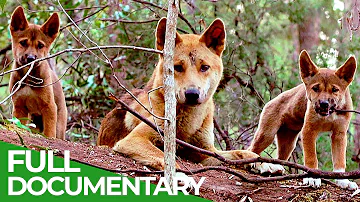
Wildlife Instincts: A Family Bond - Dingoes | Free Documentary Nature
Wildlife Instincts - Episode 5: A Family Bond - Dingoes | Free Nature Documentary Watch "Wildlife Instincts: Pallas's Cat - Master ...
Free Documentary - Nature
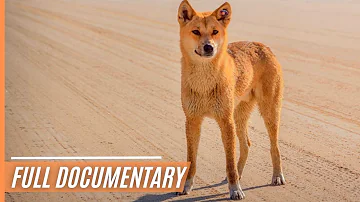
A Unique Insights into Australia`s Top Land Predator - The Dingo | Full Documentary
For several years, dingo expert Brad Purcell has been following a pack in a secret Blue Mountain valley. Last year, for the first time ...
Free High-Quality Documentaries

Dingo: The King of Australia
----------- This episode was shot earlier this year before the mandatory lockdown. ----------- Support Animalogic on Patreon: ...
Animalogic

WILD AUSTRALIA | The Continent of the Strangest Predators #naturedocumentaries | Wild Nature
WILD AUSTRALIA | The Continent of the Strangest Predators #naturedocumentaries Welcome to an epic adventure through ...
WILD NATURE - Nature animal documentary

Dingo Fast Food | Nat Geo Wild
About National Geographic Wild: National Geographic Wild is a place for all things animals and for animal-lovers alike. Take a ...
Nat Geo Animals
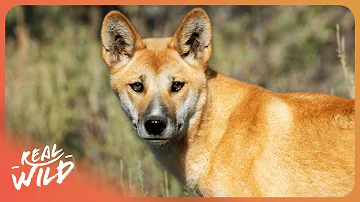
From Puppy to Apex Predator: How Dingos Survive in The Wild
In this episode, we follow the lives of dingos in Southeastern Australia, exploring their survival strategies, complex social structure, ...
Real Wild
🌍Habitat Information
The Dingo typically inhabits Australian deserts, grasslands, forests, and scrublands environments. Dingos have adapted to their environments with specialized features and behaviors.
Primary Habitat:
Australian deserts, grasslands, forests, and scrublands
More detailed habitat information will be available soon.
🛡️Conservation Status
The Dingo is currently classified as Vulnerable. Conservation efforts are crucial for preserving this species for future generations.
Common Threats:
- 🏠Habitat loss and fragmentation
- 🌡️Climate change impacts
- 🎯Hunting and poaching
- 🏭Human-wildlife conflict
⚠️Threats & Conservation Challenges
The primary threat to pure dingo populations is hybridization with domestic and feral dogs (Canis lupus familiaris), leading to genetic dilution and loss of unique adaptations. Habitat loss, persecution by humans (especially as livestock predators), and control measures such as poisoning and shooting also pose significant risks. The construction of the dingo fence in southeastern Australia has fragmented populations and limited gene flow. Disease transmission from domestic dogs, such as canine distemper and parvovirus, further threatens dingo health. Despite these challenges, dingoes remain widespread, though pure populations are declining, particularly in the southeast and along the east coast. Conservation efforts are complicated by the difficulty in distinguishing pure dingoes from hybrids.
🔬Scientific Classification
Scientific Name
Canis lupus dingo
Classification Hierarchy
🔍 About Taxonomic Classification
Taxonomic classification is a hierarchical system used by scientists to classify and organize living organisms based on shared characteristics and evolutionary relationships.
The system moves from broad categories (Kingdom) to increasingly specific ones, with each animal's scientific name typically consisting of its Genus and species.
📝Community Notes
Share your observations and insights about the Dingo with our community of wildlife enthusiasts.
Join Our Community
Sign in to share your observations and connect with fellow wildlife enthusiasts.
Sign In to ContributeNo community notes yet
Be the first to share your observations about the Dingo!
Explore Dingo
Select a tab above to learn more about this amazing animal.
📸Photo Gallery
No photos available for this animal yet.
🌟Discover More Wildlife
Continue your journey of discovery with more fascinating animals from our database
